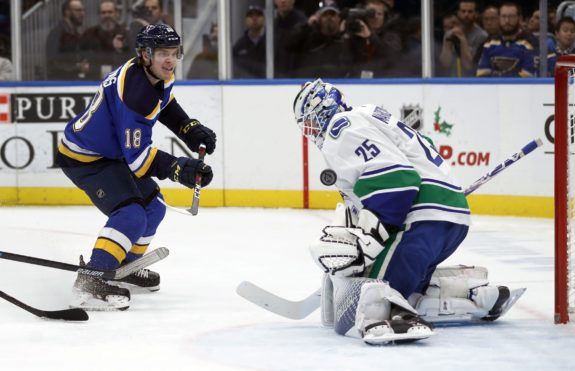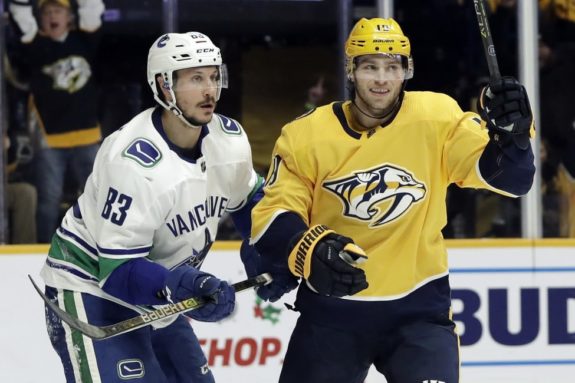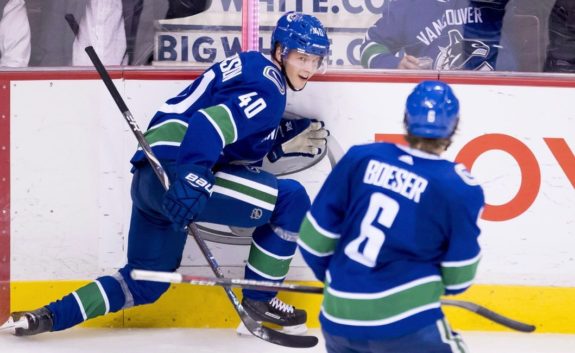![]()
While the Vancouver Canucks’ 4-0 loss to New Jersey on Monday may have halted the team’s momentum, it’s hard not to look at the Western Conference standings with some level of optimism.
Thanks to a trifecta of former contenders — Chicago Blackhawks, LA Kings and St. Louis Blues — severely underperforming, the playoff picture is wide open, not just for a ‘bubble’ team like the Edmonton Oilers, but even for Vancouver.
At the beginning of the season, the idea that the Canucks would have a realistic shot at the playoffs at the halfway point of the year would have been laughable. Yet, thanks to an 8-3-1 stretch, there they are, just two points behind the eighth-place Dallas Stars with a 19-19-4 record.
This article will not discuss what their playoff chances actually are (probably still not great…they are just .500 after all). Instead, it will examine what made them successful last month.
Jacob Markstrom
You are nothing without consistent goaltending, and that has been a major problem for Jacob Markstrom. Last season, he and Cam Talbot were the only goalies in the NHL to post a sub .900 save percentage (SV%) in 25 or more games, while also recording a .925 or better SV% in 25 or more games. You get the good with him, but you also get plenty of bad.
Disclaimer: I am not a Markstrom fan. I was when he was a highly-touted prospect for the Florida Panthers, but as he got older and was given plenty of opportunity, he never was able to solidify himself as a capable starter. While his inconsistency is a big reason why I think the Canucks will eventually drop out of the playoff picture, there is no denying he was lights out in December.
Wanna hear something crazy?
Since the start of December, Markstrom has been the best goalie in the NHL.
He's 8-1-0 with a .943 save percentage.
— Jason Brough 🙁 (@SadClubCommish) December 30, 2018
While Markstrom stopped 246 of 261 shots in December, for a .943 SV% in nine starts, Anders Nilsson went 0-4-1 with an .885 SV%. Nilsson allowed more goals in his five starts (17) than Markstrom did in nine starts (15).
The impressive thing is that Markstrom is not piling up saves on shots from the perimeter only.
The Canucks have been one of the worst teams in the NHL when it comes to allowing high danger scoring chances (HDCA). On the season as a whole, they have allowed the sixth-most, at 381 (9.07 HDCA/game). From Dec. 6 to Jan. 1, the stretch where they’ve gone 8-3-1, the Canucks still allowed the eighth-most in the NHL, at 109 (9.08 HDCA/game).
Not much of a difference in terms of the quality of chances the team has allowed, but Markstrom’s personal HDSV% at 5-on-5 in his last nine starts is second-best in the NHL, at .907 (minimum 300 minutes played). Over the course of the entire season thus far, Markstrom’s HDSV% is .850 (still 10th in the NHL).

Markstrom has also played much better as of late on the penalty kill. In his last nine starts he has stopped 24 of 26 shots in 41 minutes of penalty killing time, for a .923 SV%. In 29 games played this year, Markstrom’s SV% while on the PK is .859 (15th out of 25 goalies that have played a minimum of 100 minutes shorthanded).
That being said, Markstrom isn’t the only Canuck that has picked up his play shorthanded.
Strong Penalty Kill
Before allowing two power play goals on Monday to the Devils, Vancouver’s penalty killing was a league-best 93.3 per cent, dating back to Dec. 6 (tied with the Buffalo Sabres). If you include Monday’s game, their PK% is still fifth-best during their 12-game stretch, at 87.9 per cent.
In their first 30 games, their PK% was a measly 74.8 per cent.
We’ve already established that Markstrom has played a vital role in the club’s improved PK, but is there anything else?
Well, the Canucks have allowed significantly fewer shorthanded chances in this last 12-game stretch compared to their season average.

Their average Corsi Against (CA) per game when shorthanded is 8.74 on the season as a whole, whereas it’s just 5.5 in their last 12. Their average Shots Against (SA) per game when shorthanded is 4.36 this season, but it’s just 3.33 in their last 12 games. It may not sound like a lot, but one less shot on goal surrendered to another team’s power play can make a big difference.
Another factor for their improved PK could very well be face-offs.
This season Vancouver has been a bad face-off team overall. They are fifth-last in the NHL at 47.8 pr cent. While their face-off percentage in their last 12 games is just as atrocious (47.6 per cent), their face-off percentage while shorthanded in their last 12 games has been quite good, with them winning 56.25 per cent of the draws — Jay Beagle has taken roughly 80 per cent of those draws.
Boeser, Pettersson Finishing
As most Canucks fans know by now, Brock Boeser is on a bit of a roll, which is something the Canucks desperately missed, given they went 2-7-2 with him out of the lineup in November.
The 21-year-old has 14 goals in 29 games this season, but 12 of his 14 goals have come in the last 17 games, meaning he had just two in his first 12 games. During the Canucks 8-3-1 stretch, Boeser has eight goals and four assists for 12 points.
Although it’s nothing new, Elias Pettersson has also been scoring as of late. The slick Swede has six goals and 10 assists for 16 points in the Canucks’ last 12 games, including this beauty of a shot against Calgary.
Another game, another 🚀🚨 from Petey! pic.twitter.com/gKXEaG9eQd
— Vancouver Canucks (@Canucks) December 30, 2018
This season, Vancouver has been notoriously bad at creating a high number of scoring chances. That was why they weren’t scoring goals.
Their 28.3 shots on goal/game is tied for third-worst in the NHL. During their 12-game stretch, they have surprisingly averaged less shots on goal per game, at just 27.6.
The difference? The shooting percentage, particularly of their stars.
As a team, their 5-on-5 shooting percentage (SH%) from the beginning of the season until Dec. 5 (the beginning of their 8-3-1 stretch) was 8.19. In their last 12 games, it is 9.88, a significant uptick. But for Boeser and Pettersson, the difference is even more stark.
Boeser recorded an 18.52 SH% in 17 games played from the beginning of the year until Dec. 5. During his last 12 games, his SH% is a whopping 27.78 per cent.
Pettersson’s season has been so miraculous that he managed a 23.53 SH% from the beginning of the year until Dec. 5 (24 games played). And during the 12-game streak, his SH% is an even better 26.67 per cent.

It’s clear this team will only go as far as Boeser, Pettersson and Bo Horvat can take them, but it’s also clear they’ll need some good penalty killing and Markstrom to streak at the right time if they are indeed going to have any kind of chance at qualifying for the post-season.